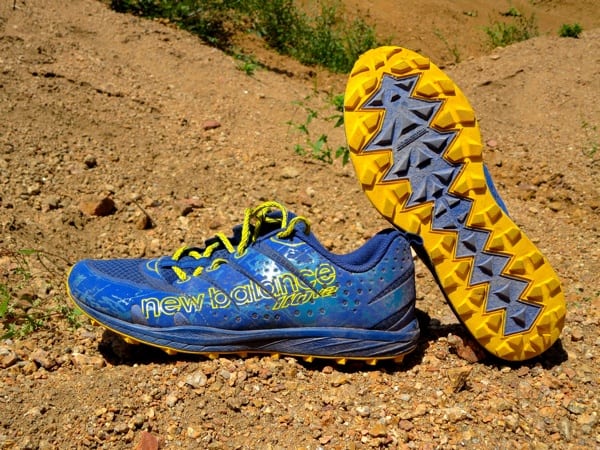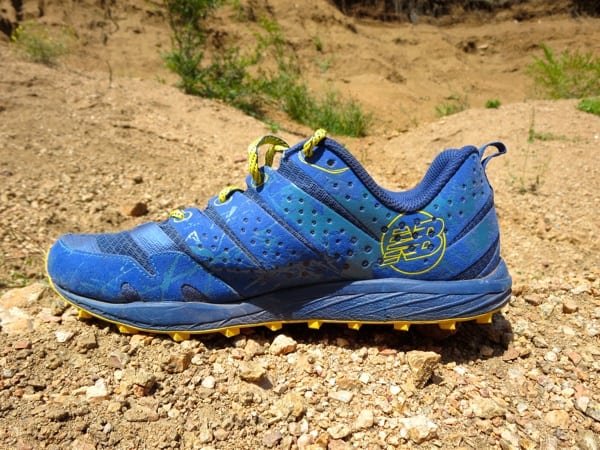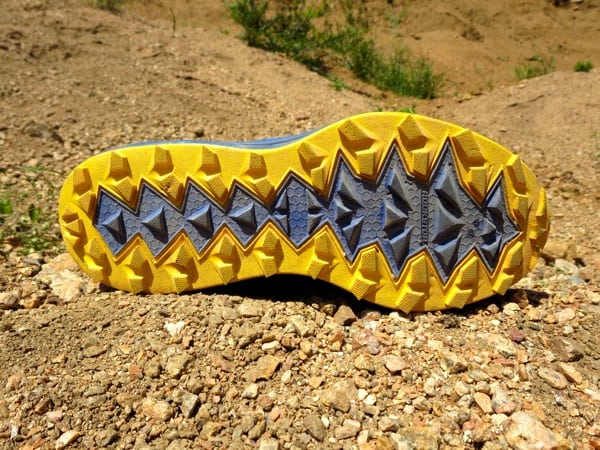Our Favorite Trail Running Shoes
Check out our Best Trail Running Shoes article to learn about our current favorite trail running shoes!
New Balance MT110v2 Review
I have received no shortage of feedback in the past, some positive and some negative, about only posting positive gear reviews on iRunFar. While the intention is to share only the shoes and gear which warrant the highest merit, I agree with some of the detractors who feel that maybe perhaps I’ve become too stringent in my choices. So, in publishing this review of the highly anticipated New Balance MT110v2 ($90), I hope to provide a well balanced but harsh critique of an update to one of the most lauded shoes in trail running.
Let me provide some background here. I started running in the MT110v2 back in April after seeing the shoe initially at the winter Outdoor Retailer show in Salt Lake City, Utah. I think the New Balance reps were a little taken back by my continual request to try on the sample size and jog around the New Balance booth despite the shoe being too small. Anyways, I trained extensively in the shoe for a period of time, racking up my own personal feedback, critiques, and biases. You see, the original MT110 has been a shoe that I have a love affair with, and each season I re-consider them for longer ultra races (50 to 100 miles) only to have my dreams sorely bruised like my feet. They’re just not enough shoe for me to log ultra distances in, but I love them for daily training. In all seriousness, I know that when I set out to review a shoe like the MT110v2 I need empirical data, feedback from other runners, and a lot of time spent in the shoe on different terrain.
So, what follows is probably a bit of an obsessed, over-analyzed version of a trail running shoe review. There will be cheers, jeers, and criticism that you probably haven’t seen in my past reviews. Remember, I am just one man, two feet, one opinion. My hope is that this review spawns some constructive criticism or praise for both my review and the shoe itself.

The New Balance MT110v2.
First Impressions
New Balance completely overhauled this newest version of the MT110 for the July 2014 release. Some of these updates made sense: a more durable upper to address some of the fragility of the original MT110, and more forgiving/softer foam cushioning in the form of NB’s Revlite. However, other updates seemed contrary to the intent and heritage of the shoe including changing the last/fit, adding on a bulky outsole, and increasing the weight by about 1.5 ounces. I tried to put my preferences for the original MT110 and MT101 aside and look at the design in and of itself, remembering that feedback was taken from both Anton Krupricka and Dominic Grossman to create a functional all-around mountain-running shoe.
Upper
A lot of runners, including myself, experienced premature ripping of the upper on the original MT110, so in response New Balance really beefed up the MT110v2’s upper. Start with big, wide, welded-on overlays just about everywhere on the shoe. Additionally, these overlays are made of a synthetic-leather material that can really take a beating. Unfortunately, that is the only positive change to the upper.

The New Balance MT110v2’s lateral upper.
New Balance decided to change the last on the new version to the popular PL-4 which works great on their road shoes such as the 890, but provides a sloppy fit with a insecure midfoot and a tapered toe box with this shoe. Added to this is an uninspired heel collar, tongue, and lacing configuration which seem to have difficulty staying tied. Forget about the NL-1 Minimus last that legions of runners came to love with a glove like midfoot and heel expanding into a foot-shaped toe box. So, I emailed the design team at New Balance and received some valuable insight:
As we began the planning for updating the trail 110v1 there were two main avenues we needed to take into account: Feedback from our ambassadors like Tony and Dom. And also how this new 110v2 will sit next to the rest of our trail models. It is this last point that is so important in our product creation process, because it really helps us determine if we have a solution for the wide range of trail runners out there. What we found when we did this, was that we had two models that were really the perfect go-to model for high-speed training runs (e.g., tempo) or the trail runners’ race day shoe. These two models were our Minimus Trail 10 and also the Trail 110v1. They were both built on our NL-1 last. As we started to compare the two we realized that the two models had some clear differences – e.g., one was mainly a mesh upper while the other was entirely a synthetic upper, but overall when put on the foot it was very difficult to draw much of a difference. The both were incredibly lightweight, had the same 4mm offset, and, of course, had the same fit: wide forefoot to allow for foot expansion while the midfoot was very fitted and slightly shallow. It was this last characteristic of a more shallow fit that would cause us to hear from certain runners that they had trouble fitting their foot in the shoe due to having a more ‘fuller’ sized foot.
This is what really helped drive the direction to build the 110v2 on our PL-4 platform. We felt that this new last would allow the trail runner who needed a slightly more generous fit then the current T10 and T110 could offer them. By maintaining the T10 series and bringing the T110v2 on the PL-4 last we felt it now allowed greater ability to address a wider group of trail runners who are looking for that race day shoe or tempo training shoe. Using the PL-4 last – which has a straighter shape addressed the consumers who felt that the NL-1 last that has a curved shape lent to a less stable ride due to the curve while the PL-4 last provided a more stable feel for some.
While I understand the design principals of not trying to duplicate models in the trail shoe line, I don’t remember the last time I saw a runner wearing any of the Minimus models at a trail or ultra race, and the last and fit has always been my personal favorite aspect of the MT110 and MT101.
Midsole
Another really positive change, in my opinion, is the use of Revlite foam in the midsole of the MT110v2. Revlite, most commonly used on New Balance road shoes, is a bit softer than the EVA compound used in past versions of the MT-series, and I feel like it breaks down and compresses much more slowly, yielding a more resilient and durable shoe. New Balance also returned the stack height of the shoe to the original MT101 specs, giving the shoe a more neutral feel. Some trail runners complained that the original MT110 caused some medial rolling during foot strike, and the feel of this version is very neutral.
You can expect the same rock plate and protection in the MT110v2, and combined with the new lugged outsole, this is the most protective incarnation of this shoe.

The New Balance MT110v2’s medial upper.
Outsole
Initially, I saw this outsole and I was very happy to see something more heavily lugged. After several runs, I found the outsole to provide a bumpy and intrusive ride on smooth trail and the occasional road, and an insecure feel on technical trail, as well. While the new full-length outsole made of New Balance’s Sticky Rubber does provide some great traction and durability, it is also fairly hard and slippery on wet surfaces. Again, the design team from New Balance’s response:
For both the upper and sole unit there were two key areas we wanted to improve from a durability aspect. The sole unit I mentioned earlier which was to give a full sheet of outsole rubber versus the exposed EVA in the midfoot which the v1 had.
The idea here was to improve traction but to also use a stickier rubber. While this was accomplished, I do feel like some of the better aspects of the ride of the MT110 were lost due to the bulkiness and heavier weight of this outsole.

The New Balance MT110v2’s outsole.
Overall Impressions
I’ve taken the MT110v2 on virtually every type of terrain I can find, challenging and re-considering my initial feedback about this shoe. However, I’m left with the exact same conclusions I had when I took my first run in the shoe back in April, and they have never become a part of my regular ‘rotation’ during training or racing. While there are some very positive changes to the MT110 heritage including the more durable upper and addition of Revlite EVA foam, the MT110v2 is a rather unfortunate update to an outstanding trail running shoe. The most notable negative change is the last, which worsens the fit of this shoe by causing an insecure feeling on technical trails due to the sloppy midfoot and forward sliding in the shoe on steep downhills.
A couple of months ago, I learned that New Balance will revive the sought after MT101, which will become part of a ‘heritage collection.’ The fact that this shoe will be released, with only minor changes, warms the cockles of my heart.
Call for Comments (from Meghan)
- Have you worn the MT110v2? What has been your overall impression of the shoe?
- How about the upper, midsole, or outsole? Do you have any comments about specific areas of the shoe that align with or counter this review?
